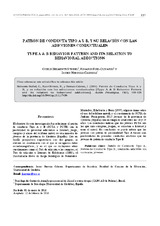Mostrar el registro sencillo del ítem
Patrón de conducta tipo A y B, y su relación con las adicciones conductuales
| dc.contributor.author | Steibel, Gisele Belmonte | |
| dc.contributor.author | Ruiz Olivares, Rosario | |
| dc.contributor.author | Herruzo Cabrera, Javier | |
| dc.date.accessioned | 2021-03-18T11:09:40Z | |
| dc.date.available | 2021-03-18T11:09:40Z | |
| dc.date.issued | 2016 | |
| dc.identifier.uri | http://hdl.handle.net/10396/21208 | |
| dc.description.abstract | El objetivo de esta investigación fue relacionar el patrón de conducta Tipo A y B (PCTA y PCTB) con la posibilidad de presentar adicciones a Internet, juego, compras y abuso del teléfono móvil en una muestra de jóvenes de la provincia de Córdoba (España). Con un diseño prospectivo expost-facto con dos grupos, se elaboró un cuestionario con el que se recogieron datos sociodemográficos, y en el que se incluyeron otros cuestionarios como el Test de adicción a las compras, el Test de adicción a Internet de Echeburúa (2003), el Cuestionario Breve de Juego Patológico de Fernández- Montalvo, Echeburúa y Baéz (1997); algunos ítems sobre el uso del teléfono móvil; y el cuestionario de PCTA de Jenkins. Participaron 3815 jóvenes de la provincia de Córdoba (España) con un rango de edad entre los 18 y 29 años. Los resultados indican que los jóvenes PCTA son los que más compran, juegan, se conectan a Internet y usan el móvil. En conclusión, se puede inferir que los jóvenes con patrón de personalidad Tipo A tienen más posibilidades de presentar conductas adictivas que los jóvenes de patrón de conducta Tipo B. | es_ES |
| dc.description.abstract | This research aimed to relate the possibility of sub¬mitting the Type A and the Type B behavior patterns to the no-substance addiction. We investigated the Internet addiction, the gambling, the shopping, and the misuse of mobile in a sample of youth people. With a prospective design ex-post-facto two groups, a questionnaire was developed to collect sociodemo¬graphic data, in which we included the Test of Shop¬ping Addiction, the Test of Internet Addiction from Echeburúa (2003), the Pathological Gambling Brief Questionnaire from Fernandez-Montalvo Echeburúa y Baez (1997), some items on Mobile Phone Usage, and the Jenkins Activity Survey. Young people from the Province of Córdoba, Spain, have participated (N = 3815, age range between 18 and 29). Results in¬dicated that young people characterized as Type A behavior pattern show bigger propension to shop¬ping, to playing, to Internet connection, and to use of mo¬bile phone. According to logistic regression, The Type B behavior pattern showed to be a protective factor for addiction to shopping. In conclusion it can be inferred that young people of Type A behavior pattern are more likely to have addictive behaviors that young people of Type B behavior pattern. | es_ES |
| dc.format.mimetype | application/pdf | es_ES |
| dc.language.iso | spa | es_ES |
| dc.publisher | UNED | es_ES |
| dc.rights | https://creativecommons.org/licenses/by-nc-nd/4.0/ | es_ES |
| dc.source | Acción Psicológica 13 (1), 119-128 (2016) | es_ES |
| dc.subject | Patrón de Conducta Tipo A | es_ES |
| dc.subject | Patrón de Conducta Tipo B | es_ES |
| dc.subject | Conductas adictivas sin sustancia | es_ES |
| dc.subject | Jóvenes | es_ES |
| dc.subject | Type A behavior pattern | es_ES |
| dc.subject | Type B behavior pattern | es_ES |
| dc.subject | No substance addictive behaviors | es_ES |
| dc.subject | Youth | es_ES |
| dc.title | Patrón de conducta tipo A y B, y su relación con las adicciones conductuales | es_ES |
| dc.title.alternative | Type A & B behavior pattern and its relation to behavioral addictions | es_ES |
| dc.type | info:eu-repo/semantics/article | es_ES |
| dc.relation.publisherversion | http://dx.doi.org/10.5944/ap.13.1.17430 | es_ES |
| dc.rights.accessRights | info:eu-repo/semantics/openAccess | es_ES |

